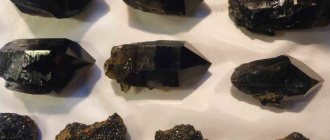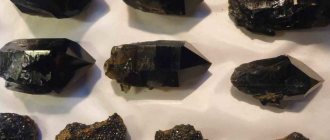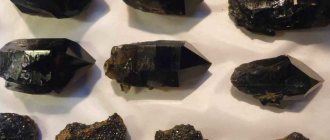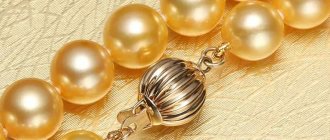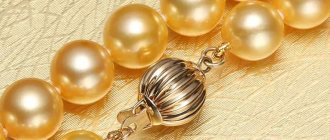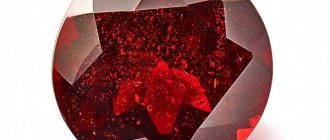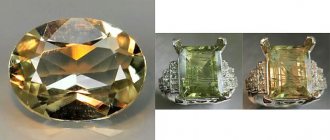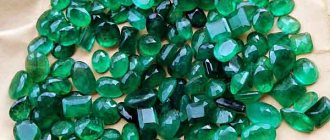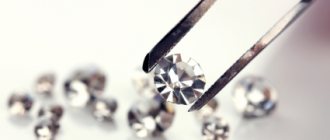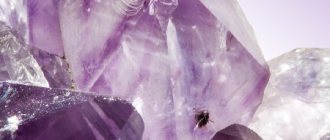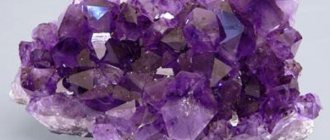Hello, dear readers! Do you already have malachite jewelry or are you just planning to buy it? In this case, you are probably wondering how to determine their authenticity. Malachite is a fantastic mineral; from ancient times to this day it has been shrouded in an aura of real magic. A talisman stone, a savior stone, a stone that connects with the secret world and opens a flow of abundance and prosperity for the owner. Of course, unscrupulous sellers often counterfeit such a wonderful mineral. From this article you will learn how to avoid becoming a victim of scammers - how to distinguish malachite from a fake.
Depletion of natural malachite deposits
Malachite initially could not be called a rare stone. However, the constant high demand for the gem led to the fact that numerous deposits were practically depleted, imitations poured into the market and the question of how to distinguish a fake from malachite began to arise more and more often.
At the moment, almost all places where stone is mined are concentrated in Africa, or more precisely in the Democratic Republic of the Congo (formerly Zaire), although previously it was actively mined in Russia, the CIS countries, and Western Europe.
In Soviet times, the Urals, Altai, and Kazakhstan were famous for their mining. But today the most famous mines of that time, in particular, in Nizhny Tagil (Mednorudyanskoye) and in Polevsky (Gumeshevskoye) are completely exhausted and do not function.
African malachite, which is the majority of the source of gem jewelry on the market today, has a number of notable features. Unlike stones previously mined in Russia, it has a larger, more regular and pronounced pattern of concentric rings. This reason, in particular, often causes problems in determining the authenticity of malachite among seasoned connoisseurs who are accustomed to the fact that a natural mineral should have an irregular, complex pattern.
The main types of imitation malachite and azurmalachite
Counterfeits of malachite are widespread, since creating them is not very difficult. Some consider this fact a disadvantage of the mineral. Although it is quite possible to distinguish a natural sample.
What artificial malachite is can be understood upon examination. It has a simpler, rougher and more contrasting pattern. There are several methods for making imitation.
- A simple fake can be easily done with your own hands from polymer clay of appropriate shades, mixing the colors.
- Cementing of the smallest particles of natural stone using hardeners.
- Sintering of natural malachite powder.
- Synthesis by the hydrothermal method, when natural conditions are artificially created.
- The so-called “pressed malachite” is plastic. It is lightweight compared to the natural option.
Industry has the ability to produce imitations, achieving a high degree of similarity with a natural sample, up to 99%. Therefore, it is not always possible to be sure that the purchased jewelry is made of natural stone.
Bracelet - classic imitation malachite
In addition to polymer clay and plastic, there is a way to imitate a mineral using acrylic paint. Shades of green, the same color as malachite itself, are applied to the primed surface, then the layer is covered with spots.
After applying the varnish, the decorative coating of the wall under the natural material is considered ready. There is also a known method of applying decorative plaster in the appropriate shades of natural stone.
Natural specimens can be distinguished on the market by their fairly high price.
Among similar minerals (in addition to pseudomalachite), it is worth paying attention to the gem azurmalachite with blue and green color combinations. It uniquely combines the qualities of azurite and malachite.
Since ancient times, it has been valued by Indian tribes, revealing a beautiful design as a result of polishing. This is an opaque copper carbonate that fades in the sun, turns green when exposed to high humidity, and is destroyed by acids. Azurmalachite is a valuable stone, so it is also imitated.
Authenticity checks may damage the natural sample.
Variants of fakes of natural malachite
Counterfeiting natural malachite is not always an attempt to deceive. Due to the fact that stone jewelry always looks especially impressive and many people want to become the owner of an eccentric pendant or decorative item, imitation is still often just a need to satisfy demand and provide an opportunity to make a purchase on a limited budget.
In other words, in most cases the seller does not hide the fact that he is offering a fake, and the options for artificial products can be as follows:
- Malachite chips. The best option is, in fact, a very low-grade original. In this case, waste is used to create jewelry - small crumbs that are formed when making a product from a real large gem. The crumbs are glued together using epoxy resin and pressed in a special way. In fact, it is difficult to say unambiguously whether it is correct to call products made from crumbs fakes, since in this case the master still works with a real mineral, which has all the magical properties of the original, and, nevertheless, in the harsh rules of the jewelry world, such products are always in a controversial place.
- Synthetic gem. This is, in general, another controversial imitation. The synthetic gem is grown in laboratory conditions. It has the same chemical formula as a natural mineral and is indistinguishable in appearance, but since it is grown “in vitro”, it does not possess the magic of a natural stone.
- Imitation. In this case, we are talking about a clear counterfeit that has nothing to do with malachite. For counterfeiting, a stone of a different type is used; it is simply painted with a malachite pattern and coated with a protective varnish.
- Glass and plastic. They can paint not only another breed, but also glass or plastic. These are the lowest-grade fakes, which will not be difficult for anyone to distinguish, at least by weight. Glass and plastic feel completely different in your hands than stone.
All types of counterfeits of a natural product should cost less than the original. So a low price is one of the ways to distinguish malachite from a fake. However, problems begin when the seller is unscrupulous and tries to deceive - pass off the imitation as a natural gem and sell it for a high price.
What does a real mineral look like?
Natural malachite is not translucent and has a low density, which makes it easier to process. The treated surface of the mineral reveals a bizarre pattern of blurry curved rings, painted in different shades of green. The color shimmers and smoothly transitions from almost colorless to dark emerald green. All this is in strict sequence, each ring has its own shade, as if a skilled artist had carefully drawn the pattern. Single-color fragments are rare.
Before processing, the sample may have a glassy sheen. But after polishing it acquires a delicate silky sheen. The stone is heat sensitive and may partially disintegrate in hot water.
During the era of the Soviet Union, Ural malachite was famous, which was mined near Sverdlovsk. Today, the main supplies of the mineral come from Zaire. Stones are also mined in the USA, Namibia, Chile, Australia, Zimbabwe, Kazakhstan and the Urals.
Color shades will tell you how to distinguish malachite from its analogue. The production of imitations is on stream; they don’t think about the variety of colors.
Therefore, stones similar to malachite are painted in 2-3 green shades and no more. Take a close look at the sample: if only three green color options alternate in it, then you have a fake mineral in your hands. Natural stone has a pattern of lines of similar but unequal shades of emerald color. The number of green gamut options reaches ten or more.
How to check malachite for authenticity
With careful inspection and a few simple experiments, determining the authenticity of a stone is not that difficult. Let's look at how to distinguish real malachite from a fake:
- Weight. First of all, we evaluate the weight. At this stage, the lowest-grade fakes - those made of plastic and glass - will be eliminated by themselves. It is worth noting that malachite is also heavier than many other stones, such as quartz, which is often used to create its imitation.
- Dullness. A real mineral is opaque, matte, its shine is barely noticeable, noble. If the mineral sparkles brightly with gloss or is transparent in light, it is certainly a fake.
- Heterogeneity. Despite the fact that the African rock, as we said above, has a regular pattern, no two identical stones exist in nature. This means that the answer to the question of how to check malachite for authenticity often lies in examining samples sold nearby. If they all look the same, you are looking at fakes; in the same case, when each gem is unique, most likely you are seeing originals.
- Shades. Heterogeneity should be expressed not only in the pattern, but also in color. When counterfeiting, the master, of course, uses several shades of paint, but, as a rule, no more than 3-4; nature creates a much more intricate play of color. It is noteworthy that they often try to pass off malachite as a coil. This is a natural breed, but less valuable. In order to identify these two minerals, you just need to carefully study the types of stones before purchasing. The obvious difference between malachite and serpentine is the shade of green; in the first case it is deep emerald, in the second it is closer to swamp.
- Test for ammonia and acids. If you have carried out an inspection, but still doubt the authenticity, and the seller insists on the naturalness of the stone, you can conduct two experiments, with the condition that if the mineral passes the test, you will definitely purchase it. These tests will slightly modify the stone, and therefore they should be carried out in an inconspicuous place, if we are talking about decoration - from its back. So, how to test malachite. The first test is to drop a drop of ammonia onto the mineral, wait a little, if this is the original, a section of the stone will turn pale and the drop itself will turn blue. The color change does not occur instantly, since natural gems are also coated with a protective varnish. The second test is acids. To make the acid, simply squeeze some lemon juice into a glass of warm water. Apply a drop of the solution to the gem; bubbles should appear on the surface, again, not immediately, if coated with varnish.
Please note that a synthetic mineral grown in a laboratory will withstand any test of authenticity. It is identical to natural in its chemical formula, physical properties and has a unique pattern. This means that there is no exact answer to the question of how to distinguish natural malachite from artificial malachite from the laboratory. In this case, the only guarantor of the authenticity of the stone is the integrity of the seller.
Well, now you know why the mineral is counterfeited today and how to distinguish malachite from an imitation. We really hope that the information provided will be helpful and useful to you. Don't forget to share it with your friends on social networks, perhaps they are planning to buy this beautiful stone right now.
Team LyubiKamni
Synthetic imitations of malachite
Imitations of malachite made of plastic are quite easy to distinguish; firstly, it is much lighter. Secondly, the temperature of a natural mineral is always colder than the environment, while plastic, on the contrary, is warm. Also, if you scratch the supposed malachite with a knife, the natural stone will produce shavings and the core will be all green; if it is a plastic imitation, then the insides of the scratch will be white. This method, of course, is not suitable if you are just going to make a purchase. Therefore, it is worth focusing on appearance and temperature.
The next type of fake is painted glass. It can be distinguished by the quality of the pattern and surface. The silky shine and texture of the stone cannot be faked; these are absolutely unique indicators. It is very difficult to draw these transitions-layers of green, so the fake will always look rough. You should not rely on such an indicator as temperature: for malachite and glass it will be the same.
Malachite is also imitated using green enamel; a sticker with a mineral pattern is applied on top of it. It can be distinguished in the same way as glass. In addition to visual characteristics, you can take advantage of the chemical properties of the stone. Since this mineral is copper based, it dissolves in acid. If you drop ammonia onto the surface of real malachite, it will turn blue. Plastic, glass, enamel will not give any reaction. You can also use citric acid or vinegar, in which case the surface of the stone will form bubbles. You need to be careful with such tests so as not to spoil the stone; do them only on the back side of the product.
The most effective and simple way to learn to distinguish a fake from a natural mineral is to carefully familiarize yourself with a natural sample. Study it as thoroughly as possible - what is its color, color depth, texture, tactile sensation. All these little things will help you make the right choice at the right time.
